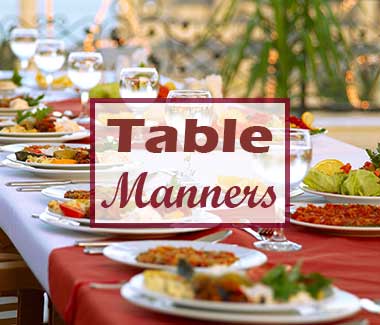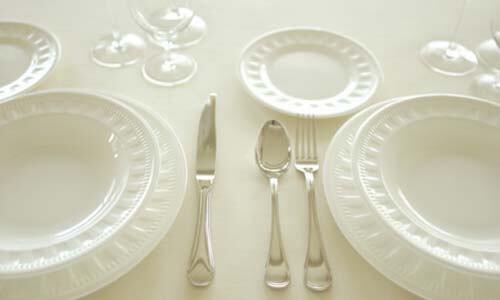Serving Utensils
Table Setting Guide
Serving utensils come in a variety of configurations to cut, spear, scoop, grasp, spread, strain, and transfer food from plates, trays, platters, and bowls. Learn more about each:
asparagus servers, berry spoons, bonbon spoons, butter knives, cake knives, carving sets, cheese servers, cold-meat forks, fish servers, flat servers, jelly servers, ladles, lemon forks, pasta forks, pastry servers, pickle forks, serving forks and serving spoons, stuffing spoons, tablespoons, and tongs
Serving utensils are placed on the table in the same way as eating utensils.
- Serving utensils are placed on the right side of serveware (because the majority of people are right-handed);
- The handles face the diner;
- When a serving spoon and serving fork are presented together, the spoon is laid on the right ready to cut and lift and the fork on the left to steady and hold.
- The utensils are returned to the platter or serving bowl in the same position.
- When a serving spoon is presented on an underplate, after use the utensil is replaced in the bowl (ready for the next person to use).
- To protect the hand, the blade of a carving knife faces inward.
Asparagus Server
Asparagus servers come in the following forms:
- Large fork with four (4) or five (5) wide tines;
- Tongs; and
- Flatbladed utensil with a rolled hood that keeps the asparagus from rolling off.
The dimensions range from approximately 9 to 10 inches in length.
Berry Spoon
The berry spoon is made with a wide shallow bowl in round or shell shapes.
It is approximately 7 ½ to 9 ½ inches in overall length.
The purpose of the berry spoon is to dish up fruit from a serving bowl, so it is also known as a fruit spoon.
Bonbon Spoon
The bonbon spoon is a small spoon made to serve candy and nuts at a tea table. This utensil, which is also known as a nut spoon and a confection spoon, has a round shallow bowl that is solid or pierced and attached to a short handle.
The bonbon spoon is approximately 4½ to 6½ inches long.
Butter Knife
Because butter is produced in rectangle form, and the butter knife is made with a dull blade to slice butter and a pointed tip to transfer cubes of butter to the plate.
The butter knife is approximately 7 inches long.
Cake Knife
The cake knife, which measures approximately 9½ to 14 inches in length, is made with a long blade that reduces the number of strokes required to cut food with a delicate texture. Some cake knives feature a serrated edge.
Carving Set
Carving sets consist of a carving knife and a carving fork. Carving sets are made in large and small sizes.
Carving Forks
- Carving forks are usually is made with a guard, a metal protrusion that extends from the shank, lifting the fork from the table and protecting the surface from soil.
- Carving forks made without guards are laid on rests, small items about 4 inches long fashioned in assorted shapes.
Carving Knives
The Large Carving Knife
- Blade approximately 11 to 15 inches long, a length that reduces the number of strokes required to carved thick cuts of meat, vegetables, and fruit, such as prime rib, pumpkin, and watermelon.
- To hold food securely, the large carving fork features two or three long, widely spaced tines.
Often the large carving set is accompanied by a steel, a metal implement with an abrasive blade about 14 inches long; the steel is used to sharpen the carving knife. Generally, the carving knife is sharpened in the kitchen, but when a steel is brought to the table it is laid horizontally above the platter with the handle facing left (in a position ready for use).
The Small Carving Set
The small carving set, also known as a steak set is used to cut food of average thickness, such as chateaubriand.
- The knife is approximately 10 ¾ inches long,
- The fork about 9 inches long, and
- The steel is about 13 inches long.
Cheese Servers
Cheese is made in assorted textures: soft, creamy, hard, brittle, smooth, firm, crumbly, coarse, and with holes. To accommodate the consistencies, cheese servers are made in numerous shapes as well.
The cheese cleaver is a miniature replica of a large meat cleaver.
- Seven (7) inches long.
- Used to slice hard cheese with a granular, brittle consistency, such as romano or parmesan cheese.
The cheese knife is made with a short curved blade that is often serrated and has two or three short tines extending from the tip.
- Six (6) to eight (8) inches.
- Used to cut firm cheese with a mealy texture, such as gouda or colby.
The cheese plane is made with a handle attached to a plane, a shape similar to a small carpenter's tool.
- Eight (8) to ten (10) inches long.
- Used to slice cheese with large or small holes, such as swiss cheese or gruyere.
- Used to slice semisoft cheese, such as monterey jack.
- Used to slice cheese with a hard texture, such as cheddar cheese.
The cheese scoop is made with a short curved blade attached to a long handle, a shape similar to a garden trowel.
- Six (6) to eight (8) inches long.
- Used to hold together a serving of crumbly semisoft cheese, such as stilton.
- Used to extract firm cheese from a wax-covered ball, such as edam or gouda.
The triangular cheese knife is made with a wedgeshaped blade, similar to a small putty knife.
- Six (6) to seven (7) inches long.
- Used to cut soft cheese with a creamy interior and an edible crust, such as brie and camembert.
Cold-Meat Fork
The cold-meat fork measures approximately 8 ¾ to 9 inches in length. It is made to spear and lift food presented on a platter, such as lamb chops, waffles, or French toast.
Fish Servers
Fish servers include both a fish knife and a fish fork.
- The fish knife is approximately 10 ½ to 12 inches long and has a long asymmetrical blade that curves to a pointed tip.
- The fish fork has three or four wide tines and is approximately 8 to 10 inches long.
Flat Server
The flat server is a round or wedge-shaped utensil, some made with a shallow bowl. Its overall length is approximately 6 to 8 inches.
The purpose of the flat server is to balance sliced food for transfer from platter to plate.
Some flat servers are pierced to drain watery foods, a utensil also known as a tomato server.
Jelly Server
The jelly server, approximately 6 to 7 inches long, is a spoon-shaped utensil with a shallow bowl and pointed tip and a flat edge on one side. It is used to serve molded jelly, such as tomato aspic.
Ladles
Ladles are serving spoons made with deep bowls in round, oval, or fluted shell shapes and various sizes.
- The small ladle is used to serve a modest amount of sauce (mayonase for instance).
- 4 ¾ to 5 ¾ inches long.
- Often found in older sets of silver.
- The medium ladle has a wider bowl than a small ladle to accommodate a larger serving of sauce, such as hollandaise or béarnaise.
- Also known as a cream sauce ladle.
- 6 ½ to 7 inches long.
- The large ladle has a wider bowl than the medium ladle, a size that holds an ample serving of sauce or gravy.
- Also known as a gravy ladle.
- 7 to 7 ½ inches long.
- The extra-large ladle accommodates the depth of the average soup tureen or punch bowl. The bowl of the soup ladle is a little larger and deeper than the punch ladle bowl and holds approximately 4 ounces of soup. The punch ladle holds about 3 ounces, but the handle is longer than that of the soup ladle to accommodate the depth of the punch bowl.
- Also known as a soup ladle and a punch ladle.
- Nine (9) to 15 1/8 inches long.
Lemon Fork
The lemon fork, approximately 4¼ inches long, is made with three narrow tines to serve sliced lemon. For easy release of the juice, the outer tines often splay outward.
Pasta Fork
The pasta fork is made with a deep oval bowl (often slotted), surrounded by large wide tines.
- Also known as a pasta server; pasta scoop and fried oyster server.
- Eleven (11) inches long.
- In older sets of silver, pasta forks have a curved edge on one side and large wide tines on the other side.
Pastry Server
The pastry server has a wide spadelike blade made to balance a serving of pastry, such as a piece of pie or cake.
- Nine (9) to 12 ½ inches long.
- Also known as a pie server or a cake server.
Pickle Fork
The pickle fork had two or three slender tines and a long narrow handle to reach deep into a pickle jar. The pickle fork is approximately 5 ½ to 8 inches in length.
Serving Fork and Serving Spoon
The serving fork and serving spoon measure approximately 9 to 10 inches and the utensils are used together or separately. As a set, the serving fork and serving spoon are used as tongs to serve food that requires two implements, such as a tossed salad or pasta. Individually, the serving fork is used to spear food from a platter, and the serving spoon to lift food from a bowl.
Stuffing Spoon
The stuffing spoon is made with an extra-large bowl and a long handle to reach deep into the cavity of turkey or other fowl.
- Thirteen (13) inches in length.
- Also known as a buffet spoon, casserole spoon, and dressing spoon.
Sugar Servers
Sugar Tong
The sugar tong is made with an inverted U shape or with grippers. The inverted-U tong is made with a spring arch that after use is hung over the handle of the sugar bowl or laid by the side of the bowl.
- Because cubes are a neater form of service than granulated sugar, tongs are used at formal and informal events.
- 3 ¼ to 6 ½ inches.
- The sugar tong with grippers features various shapes, such as petite shells, fork tines. or tiny oval spoons, and it is shorter than sugar tongs with grooved grippers found in older sets of silver.
Sugar Spoon
The sugar spoon is used to serve granulated sugar, a consistency easy to adjust and faster to dissolve than cubed sugar.
- Used at informal meals.
- 5½ to 6½ inches long.
- Also known as a sugar scoop or a sugar shell.
Tablespoon
Tablespoons frequently have a pierced bowl in order to drain food.
- 8½ to 9½ inches long.
- Also known as a vegetable spoon and a buffet spoon.
Tongs
The tong is a twin-armed implement made in various shapes and designed to grasp and lift portions of food.
- The flat-bladed tong is made with two wide blades to grip and serve food.
- Used to serve small whole potatoes, rolls, pastries, and waffles.
- 5 to 10 inches long.
- Some have grippers with slots to drain watery vegetables, such as asparagus.
- The scissor tong is a hinged utensil joined together at the handle, a shape similar to scissors. To grasp mixed salads or vegetables, the utensil is often made with a large spoon on one side and a fork on the other side.
- 10 inches long.
- The inverted-U tong features a sturdy spring arch. It is made with grippers in different forms, such as shells to serve pasta or claws to grasp ice cubes.
- 8 to 10 inches long.



